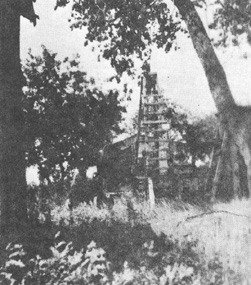
Only picture discovered of the old gold, mine which operated ot the west edge of town Shown is a derrick and old gasoline engine. An old barn stood at the left. Picture furnished by Katherine Fullwood.
GOLD MINE
Gold!!! When it was discovered in California and Alaska all trails led to the west and new opportunities but when it was discovered in Wymore it hardly stirred a ripple on the outside world. Did we say that gold was discovered in Wymore? Well we mean just that. Not only discovered but a development company formed to work the "diggings." The story dates back a long time ago to January, 1907 in fact. Joe Brown, a well driller, lost his bit while drilling for water on the old Simmons place west of town. In trying to "fish" out the bit from the well shaft the workmen brought up some gravel and on closer analysis discovered that it contained gold.
Gold does a lot of things since it is the next thing to money or money is the next thing to it, either way one gets the other. Gold has many uses, but then this isn't to tell you about its uses or its value, we're only interested in what its discovery |
locally did for Wymore. A company was formed, stock was issued and digging began in earnest. The officers of the company were A. R. Norris, president; C. M. Murdock, secretary; Dave Fouts, treasurer. The mine was worked by J. M. McDonald as late as June, 1921.
For around twenty years there was an off and on effort to develop local mines, there being one south of town that was worked to some extent but to no avail. All efforts were finally given up around 1921.
FARMERS & MERCHANTS BANK ROBBED
Only one bank robbery has been reported in the files of the Wymore newspapers and that occurred on May 26, 1928. The following account of the robbery was taken from those files.
At 9:30 in the morning, six men drove in to Wymore in a dark red Nash car. Five of the men entered the bank and ordered the officers, W. C. Oelkers, president; A. I. Baker, cashier, and Mrs. Clara McAdams, bookkeeper, to lie face down on the floor. Several thousand dollars in currency and silver with a quantity of securities were scooped into sacks and carried away.
J. V. Neumann, janitor, was down in the basement getting out some screens to put on the windows. Hearing an unusual commotion upstairs, he came up and peeped through the door. Seeing the bank was being robbed, he went into the Ed Taylor barber shop just west of the bank but in the same building. Here the alarm was telephoned.
Dr. R. J. Hinman, who with Dr. C. W. Thomas were located in the same offices they now occupy, and Marie Long, who worked for them, heard some commotion and went to the door. Dr. Hinman reports that a car was standing in the middle of the street with one man by its side. He saw the man raise his arm and bring it down and then brick dust flew in their face, the bullet striking at the east side of the door.
Mayme Whalen, who was in Dr. Gillespie's office over the bank also looked out the window and a shot was sent in that direction. John Piel, an elderly man, also observed the robbery from the street.
As the car started, another bullet was sent through the bank window and into the ceiling. The car went west to the library corner, north to K street, west to 11th, north to the Campbell home and then west to the highway. Three miles west of Blue Springs it turned south but they were safely on their way, having sprinkled the roads with roofing nails. |
 |
| 40 |
|
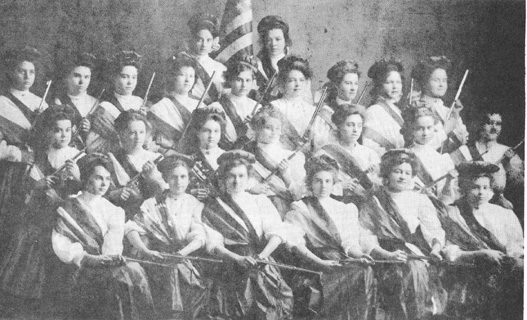 |
The G. A. R.. or "The Girls Rifle Association" which was organized in Wymore in 1908 by Mrs. J. Jeffrey for the benefit of the Cemetery Association The first appearance of the drill in public was given on March 2, 1908 at the opera house. The newspaper story concerning the organization stated the organization had given several entertainments in which it had been very successful The costumes consisted of a red skirt and cap, white waists and red, white and blue sash.
Members of the organization were, left to right, 1st row: Thersa Helmig, Neva Cole, Donna Baumgardner, Maud Robertson, Fern Jeffrey, Ruth Jones 2nd row: Bernice Richey, Dora Hammond, Dorothy Kauffman, Elsie Hirmon. Ethel Garfett, Mildred Stewart, Louise Mosher 3rd row: Estella Rainy, Mable Clayton, Mae Clayton, Maguerite Stevens, Zoa Warden, Verna Knight, Ruth Philbrick, Ina Huckett, Lina Wilson The two standing: Hattie Hardin, Helen Temple. |
MANY BUSINESS VENTURES OVER THE YEARS
Numerous business activities, large and small, originated and lived temporarily in Wymore. The ventures were so numerous there is neither time nor space to cover each individually. However as a matter of record they should be mentioned.
The stone quarries no doubt were the most important in their day, though there also was the plaster mill, lime kilns and brick yards. Then came cement blocks, made here off and on until a few years ago.
There was the Black Bros. Flour Mill, a few years ago rated as the 5th largest in the state, but following World War II, like dozens of others over the state it ceased to become a mill and is used as an elevator and storage bins.
Others in earlier days included the cheese factory, the cigar factory, glove factory, creamery, Mo-Lash fish bait, H. D. Chemical Co., Wymore Foundry

|
and Die Casting, Cemetery Marker factory, window shade factory, Rat Squill Mfg Co., Barney O. Youll Fire Extinguisher and perhaps others of lesser importance. All have served the purpose of their day and for one reason or another ceased to exist.
New inventions now being patented are Roy Day's Stay-Lit stock tank heater and Frank Lisec's poultry watering fountain, this inventor living on Wymore rural route No. one. If the patents are obtained these may grow into large plants in time to come.
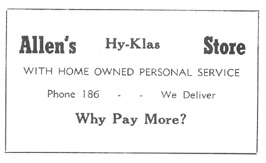
|
| | 41 |
|
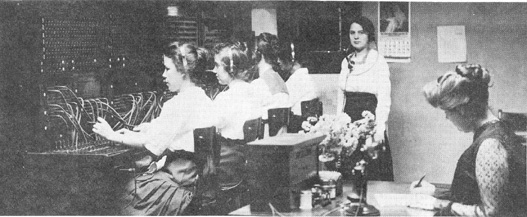 |
The operating department of the Wymore Telephone Co. back in 1915 was a far cry from the efficient office of today. The lady at the right was Hazel Wheeler, chief operator, now Mrs. Rex Bowery of Wymore. Others from left to right were Minnie Harris, now Mrs Sterling Wallace of Beatrice; Stella Childs, daughter of Ed Childs of this city. Next two were unidentified but the lady standing was Etta Brown, now Mrs. Tom Dunn, a Beatrice resident until recent years. |
THE TELEPHONE SYSTEM
According to information carried in The Arbor State October 7, 1954 at the rime the Lincoln Tel. & Teleg. Co observed their 50th anniversary, the new city did without the convenience of telephones for several years after it was founded back in 1881.
According to early records, it is said there was one telephone here in 1884. In 1886 the number had grown to 16. It is possible that they were served from a Blue Springs office.
According to a story published in the Beatrice Sun in 1902, Blue Springs was the headquarters for many telephone lines in this area. The Gage County Independent Telephone Co. then had a central office at Blue Springs with 65 telephones connected on four party lines which had been built in less than 90 days. The story went on to say that other lines were to be built and arrangements made to connect with the Independent telephone company at. Liberty which served Gage county and north Marshall County, Kansas.
In January, 1906 a franchise was granted Frank M Smith by the Wymore city council for an Independent Telephone Co. and Mr. Smith agreed to build lines to connect with the New Home Co. at Beatrice. Later that year the New Home Telephone |
Co built an exchange at Wymore with a switchboard located in the Fenton Block at Bloomington and Niagara streets.
Wymore was also one of the early exchanges of the Bell System in Nebraska. Their first office was located above the present Ben Franklin Store at the time the Wymore State Bank was on that corner Later the office was moved to the John W. Smith building at 217˝ South 7th where it remained until it was moved to its present location in 1928.
In March 1906, the New Home Co. announced that a line had been built from Wymore and Blue Springs to Beatrice At that time there were only 17 telephones in Wymore. Later in the same year the Bell company also announced they had completed a line to Beatrice. The following year the New Home company closed a 95-year contract with the Gage County Independent Telephone Company for an inter-connection of toll lines.
The above mentioned article in The Arbor State continues as follows:
"In 1909 The Lincoln Telephone and Telegraph Company purchased the New Home system, which included the exchange at Wymore; and later, in 1912, it also purchased the Bell exchange here and consolidated the two into a single operating exchange. |
 |
| 42 |
|
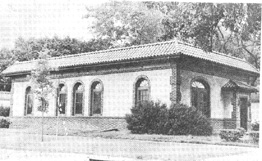
This attractive building owned by the Lincoln Tel. & Teleg. Co. at the corner of 7th and H streets was built in 1928.
At that time there were 530 telephones at Wymore, and the consolidation meant that telephone subscribers here no longer had to have two telephones for complete service. Under the former arrangement the lines of the two companies did not interconnect and it was necessary for subscribers to pay for two telephones if they desired complete service in the area. The same situation applied also to long distance service because both Bell and Independent companies had their own long distance lines which also did not interconnect. The situation with respect to consolidation of long distance service also was remedied in 1912 when Bell and Indepedent companies throughout the United States reached an agreement for a national unified long distance system.
"In 1912 the Lincoln company also reached an agreement with the Bell organization for a general division of property in Nebraska. The Bell company withdrew from the area south of the Platte River westward to Adams and Webster Counties and LT&T purchased all of the Bell properties in these 22 counties. A number of other Independent properties were also purchased at that time.
"Today LT&T is the largest Independent telephone company in Nebraska and one of the largest in the United States. It serves 115,000 telephones in southeast Nebraska, about one-fourth of the telephones in the state.
"LT&T managers at Wymore in recent years include Roy J. Rogers, Roy Mills, Dan Smith, Lloyd Oglesby, and the present manager, M. J. Danaher, who moved here in 1952."
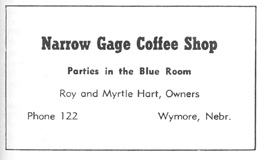
|
WYMORE RESOURCES
The Weekly Wymorean of June 5, 1913— Articles of incorporation are being prepared for the Wonder Mercantile and Manufacturing company. The capital stock is $51,000. The incorporators are Savannah B. Wonder, James A. Wonder and Charles A. Wonder. One of the principal purposes of the new company -is the development of some pottery clay deposits located near Wymore, Nebraska. This property consist of 35 acres of land which has come into possession of the sons through the estate of their mother who recently died. In 1876 their father bought a tract of land of about 200 acres on the Big Blue river. Part of this land run .under a bluff and was considered of no value whatever. Explorations during the past few years by the United States Geological survey have disclosed the fact that this bluff contains a stratum of clay sixty feet wide that carries cream, blue and red clay said to be the finest in the United States. The clay can be used for pottery and sewer pipe as well as fancy brick.
From The Wymorean, July 9, 1894: The Wymore Bicycle Club, having leased the race track at the fair grounds, no horses or teams will be permitted upon it, as the sharp corks upon horses shoes cut the track up and make it rough. People in carriages and on horseback can secure a good view of the sport from near the entrance.
The members of the club have been out parading for several evenings past and are beginning to execute the various maneuvers very nicely. A Japanese lantern parade will be given some evening in the near future.
Bicyclists desiring to use the track may enter through the small gate on Norwich street, or get a key from the president or secretary and enter the wagon gate on Niagara Avenue.
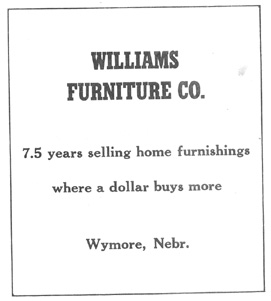
|
| | 43 |
|
BANKING
On October 25, 1881, Horace A. Greenwood who had formerly lived at Red Oak, Iowa, established the first bank in Wymore. The following year Benjamin Burch, his son John C. Burch and M. A. Southwick came to Wymore for the same purpose and were about to start a new bank when Mr. Greenwood sold them his institution and retired for the time from the banking business. The Bank of Wymore, under the management of its new proprietors did a flourishing business for more than ten years, but during the great financial panic which began in 1893 and lasted several years, the bank was forced out of business and passed into the hands of receivers.
About the time the Bank of Wymore was purchased by the Burchs and Southwick, a brick bank building was erected by Joseph R. Dodds on the corner south of the Touzalin Hotel, that being the first brick building in Wymore, and the Citizens Bank was established in it by Elisha P. Reynolds and his sons. Some years afterwards this became the property of Samuel Wymore and E. C. Wilcox, with Wilcox as cashier and as the one in principal charge of the bank's fortunes. About the time of the 1893 financial panic this bank liquidated its obligations and ceased to exist.
Succeeding these two early ventures in banking, the First National Bank of Wymore was founded by Horace A. Greenwood and others, and, probably about the same time, the Farmers & Merchants Bank came into existence. These were both exceptionally strong institutions for a town of the population of Wymore and each possessed a fine bank building. J. A. Reuling was president of the First National; G. L. Stephenson, vice-president; John S. Jones, cashier; and D. K. Windle, assistant cashier. Sherman Taylor was president of the Farmers & Merchants Bank; W. A. Dawson, vice-president; L. E. Lefferdink, cashier; A. L.
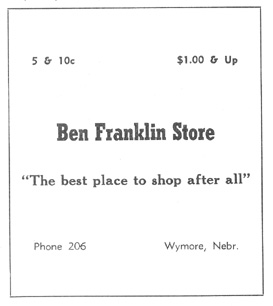
|
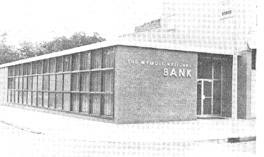
The new, modern bank building completed this spring by the Wymore National Bank.
Baker and C. F. StilIwell, assistant cashier.
During the depression and drought of the thirties the Farmers & Merchants Bank closed its doors. Later the First National Bank closed and opened under a new organization as the Wymore National Bank.
The bank opened for business at noon on October 15, 1934, one of the worst of the drought years. It had total assets of $267,000 and the first officers were W A. Stahl, president; C. B. Ellis, vice-president; L. Boyd Rist, cashier and Gordon Jones, assistant cashier.
The bank continued in its location in the Greenwood building until a new modern building was completed and it moved into the new building in March of this year. In July this year, the bank listed total assets of $1,831,000 and deposits of $1,342,000, showing a healthy increase since its opening 12 years ago. Present officers are C B. Ellis, president; L. Boyd Rist, vice-president and cashier; Martha Thomas and Lewis H. Jones, assistant cashiers.
BIG NOISE AND CELEBRATION
"Taken from The Weekly Wymorean of Nov. 19, 1892: On Thursday there was a gathering of the clan to appropriately celebrate the election of Grover Cleveland. The fun commenced about three o'clock in the afternoon when Frank Acton wheeled Charley Jansen around a block in a wheelbarrow in payment of an election bet. In the procession close behind came M. Weston wheeling P. F. Thiessen in a baggage cart. Later in the day Frank Acton climbed a telegraph pole to appease another man who had won on Cleveland The principal feature of the program throughout the afternoon was noise. The air was made hideous with the blare of tin horns, and whistles and this was kept up until after twelve o'clock at night. Herman Kunze fired up his engine, attached a belt to the hand organ' and play ta-ta-boom-a-de-ra eight hours in rapid succession without ever stopping to oil a crank pin. In the interest of harmony a stone was tied to the wistle on the engine and rush of escaping steam is reported to have been heard at Marysville. In the evening there was a procession and a brilliant display of fireworks. When the marching column reached the top of the hill overlooking Blue Springs, a match was touched to the great sacrifice and a column of fire was sent on high to light Grover on his way.
|
| 44 |
|
PAVING VALUABLE ASSET TO TOWN
The following article concerning Wymore's paving was taken from The Arbor State October 21, 1948 as given by Clem Hutson, then street commissioner:
Perhaps the first thing to be noticed by newcomers and visitors in Wymore are its numerous paved streets. And well they might be, for this little city of a bit less than 2,500 people boosts nearly ten miles of pavement within its city limits. An estimate of the cost of the paving today places its value within the mark of $500,000.00.
But that's not all—there's also 20 miles of graveled and dirt streets within the city which are usually well kept. Several miles of graveled streets keep many folks on the outer fringe of town out of the mud.
Wymore began its movement to get "out of the mud" back in 1923 when the ten blocks of brick paving were laid in the business district. Previous to that, according to old timers, in bad weather it was almost impossible for a team to pull an empty wagon down the street.
The movement was apparently well received for the following two years, 1924 and 1925, eighty blocks of asphalt paving were laid by contractors. This included a total of 69,000 square yards and was a size-able objective for the citizens to tackle. The paving consisted of a 4 1/2 inch base with 1 1/2 inch sheet of asphalt.
From reports we have been able to gather, that ended the paving until WPA days when various gaps were filled in. WPA labor was put to good use (there was no leaf raking here) and the city benefitted considerably in its paving program.
During those days, paving was laid on Highway 77 city route for 14 blocks, North 7th was extended to meet Blue Springs, west M street, from the park entrance to 14th was paved, on D street from 7th to 14th and on the cemetery rood from 14th to 17th. Thus another 35 blocks of paving was added in the city.
During all these years, the paving has stood up well and there has been but little maintenance. Last year it was decided that the time had come when the paving must have some attention before it started going to pieces. A three year program was agreed upon by the city council and street commissioner Clem Hutson.
Clem, who has been with the city since 1936, was a little better equipped to handle the job than he was back in the days when he was appointed to the position. At that time he inherited a 2-wheel cart, a broom and two shovels. A Model A pick-up truck was owned by the city and served both the street and water and light departments.
In 1942, the city purchased a 12-ft., 65 h.p. maintainer, the last to come off the assembly line before production was frozen by the government. In 1944, an asphalt heater and distributor was purchased to make repairs in cracks which were appearing in the paving. Left from WPA days was a home made roller, filled with cement which weighs 5 tons and gives 240 pounds pressure per square inch.
With this equipment, the summer program got under way last year and many of the intersections were resurfaced In many places it was found that the |
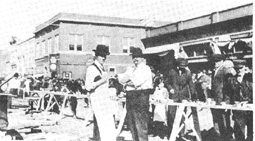
Barbecue celebrating completion of the downtown paving. Leo Holmes roasted 3,500 pounds of meat which took all day and all night to roast. 6,000 buns were baked by the three bakeries owned and operated by Leu Burkhalter, Herb Lippold and Leo Holmes. Leo Holmes and Tony Hirmon, shown in the foreground of the picture, served the meat.
1 1/2 inches of asphalt had worn down to three-eights of an inch or less.
This year the program included the resurfacing of north and south streets. When the program ends this week on North 7th street, 40 blocks will have been given two coots of asphalt and sand. Next year the east and west streets will receive the same treatment.
The three year program, planned at a cost of $9,000, is being paid out of profits from the light department. Ordinary street maintenance is paid from less than a 4 mill levy plus gas tax which runs about $2,400 a year. Cost of the resurfacing is about 13c a square yard, which includes labor, materials, depreciation on equipment, etc. The lowest estimate given by a contractor was 19c a square yard. The work has been done by Mr Hutson and four helpers.
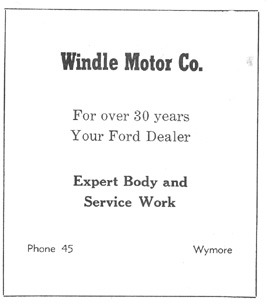
|
| | 45 |
|
G.A.R. REUNION ATTENDED BY THOUSANDS
The reunion of the G.A.R. called together hundreds of veterans and their families, many of whom pitched their white tents and camped on the grounds during the week of celebration.
Great preparation was made for the Grand Army of the Republic encampment. The following article was taken from the Daily Wymorean of Aug. 19, 1899: "Camp Lawton at Horseshoe Park is being transformed from a lonesome park of trees to a city of tents, buildings, merry-go-round, dance platforms, and small stands, as fast as the army of carpenters can finish it up. The park will be in readiness Monday to receive the campers and the large amount of work which has been done there the past few days will surprise our citizens who have not been there for a week or two.
"During the past week three wells have been sunk on the grounds and a test proves that they will furnish all the water needed.
The pontoon bridge has also been completed and will serve to shorten the distance considerably for those walking to the grounds.
"The underbrush has all been cleared away, and the park now presents a beautiful appearance.
"Every day will be a big day, and many people are expected here on Monday, especially those who intend camping. The Mound City, Mo., post will be here eighty strong, Monday evening, likewise the St. Joe post and hundreds of other veterans."
From the Daily Wymorean of Aug. 24, 1899 "The big reunion is now in full blast and to say that it is a success is a mild expression. Where all the people came from is hard to understand but they are here and are enjoying themselves hugely. The crowd is conservatively estimated at 10,000 people. Every incoming train was loaded with people today and the country folks and those from nearby towns who drove,
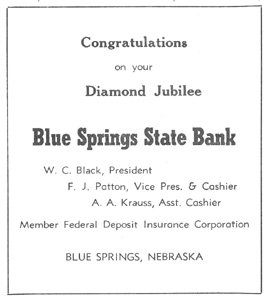
|
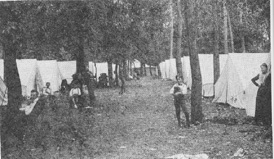
A scene at the camp grounds during the G.A.R. reunion. Wouldn't it be nice to have the time for these old-time gatherings once again?
have swelled the crowd until the pretty park is a surging mass of humanity. There are more than a hundred concessions on the grounds and all are doing a rushing business today.
"The program today was an interesting one and was listened to by thousands of people, and even then they were not missed from the other parts of the grounds.
"Much praise was given to the people of Wymore for the success of this reunion. The following are excerpts taken from an article appearing in the Aug. 25th, 1899 issue of the State Journal: The universal verdict of all is that the management of the affair is a credit to the enterprising people of Gage county's southern capital. The arrangement of the grounds, the provisions made for the entertainment of the visitors and everything in connection with the gathering reflecting credit on the people of Wymore. The undertaking was one which many larger towns would hesitate before taking up, but the people of Wymore have been equal to every emergency. The reunion is a big success."
The officers of the G.A.R. organization at this time were: Dist. Com., E. W. Poor; S.V.C., E. O. Bishop; J.V.C., Alfred McKinney; Chaplain, Wm. Taylor; M.D, J. V. Roop; Q.M. I. R. Clayton; O.D., James Crawford; O.G., Enos Frost; Adjt., M. H. Southwick.
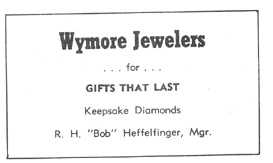
|
| 46 |
|

